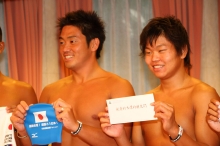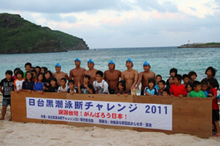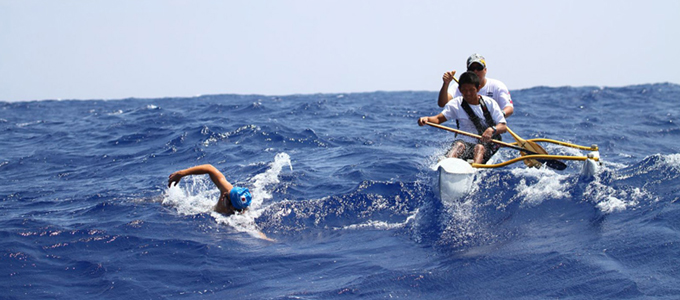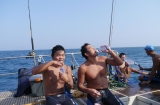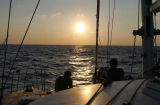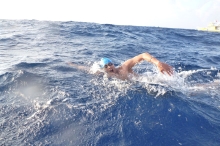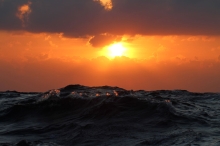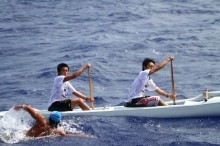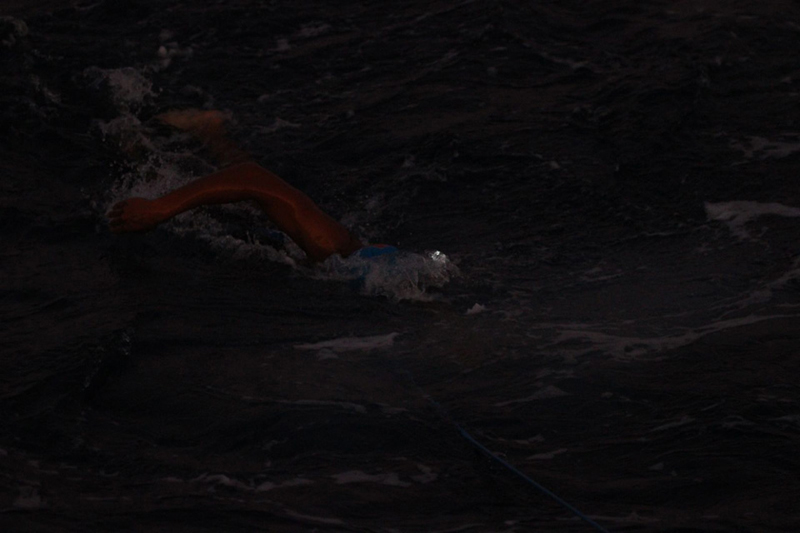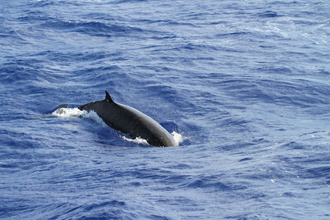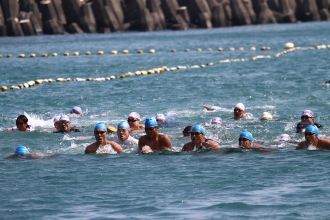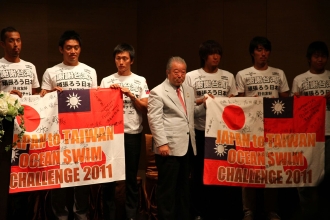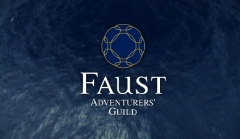
The 110 Kilometer Ocean Swim To Strengthen the Bond Between Japan and Taiwan
Kazuya Suzuki
Ocean athlete
The most important event that occurred in Japan in 2011 was the Great East Japan Earthquake. This event, which is said to have changed Japan, completely changed our attitude towards a multitude of issues including the economy, culture, education, and energy. Particularly notable among these are our attitude towards social contribution and charitable work. Since the Great East Japan Earthquake, numerous social contribution activities rooted in unending goodwill have taken place. Among these activities is one that didn't garner major media attention, but is nonetheless unique, heartwarming, and exemplifies Faust's type of social contribution. This story is about a group of inspirational swimmers that swam across the ocean from Okinawa to Taiwan, to convey gratitude to Taiwan for their Great East Japan Earthquake relief fund.
From Faust A.G. Channel on [YouTube]
Six swimmers begin their swim in rough seas while a typhoon approaches! An inspirational look back, from the project's preparation to the final ceremony in Taiwan.
The footage can also be seen at Faust A.G's YouTube channel (recommended for smartphone users)
"It looks dangerous out there".
Kazuya Suzuki was gauging the conditions of the ocean. The conditions led him to consider calling off the swim. The ocean off the island of Yonagunijima in Okinawa was starting to churn strongly due to Typhoon Number 15 which had remained stationary to the north east. He knew, however, that he was able to reach this point thanks to the support of many people from both Taiwan and Japan. Ending everything here was not an option.
His Goal: Leaving Something to be Remembered
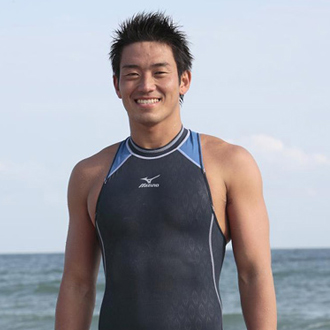 Suzuki has very defined back and chest muscles as well as large hands - testament of a serious waterman.
Suzuki has very defined back and chest muscles as well as large hands - testament of a serious waterman.
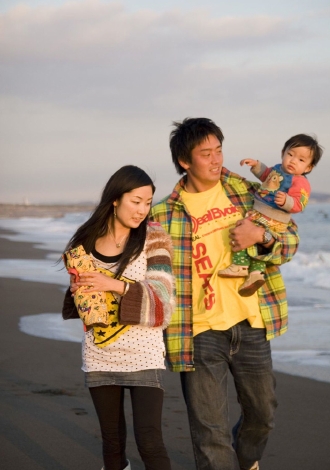
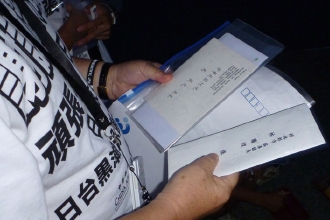 Letters of gratitude provided by the governors of disaster-stricken areas Iwate, Miyagi, and Fukushima to be handed to President Ma Ying-jeou.
Letters of gratitude provided by the governors of disaster-stricken areas Iwate, Miyagi, and Fukushima to be handed to President Ma Ying-jeou.
While all of Japan was still reeling after the Great East Japan Earthquake, Taiwan donated over 20 billion yen to Japan and was the first country in the world to send rescue crews. Why did Taiwan provide so much support to Japan? This question is the basis of this challenge.
"Tracing back the history of Japan and Taiwan, I learned many things. Our predecessors endured many events throughout history. They strengthened cultural and economic ties while establishing the foundation for friendly relations. I believe that this relationship is why the people of Taiwan lent their hand in support of Japan. So I wondered if there was anything young people like me can do. I came up with the challenge of swimming from Yonagunijima island to Taiwan to convey our message of gratitude," explained Suzuki. The "Japan to Taiwan Ocean Swim" idea came relatively suddenly, but Suzuki already had been preparing for this challenge. Suzuki was an office worker at Panasonic (at the time, October 2011), but swam competitively during college. After graduation, he worked as a respected lifeguard. His large hands, broad chest, and defined back muscles are testament of a man that spent serious time in the water. In 2009, he swam 68 kilometers from Izu Oshima across to Chigasaki, which took him 22 hours. He decided to take on this extreme long-distance swim to teach the importance of never giving up and always facing challenges to his child, who was battling infantile hernia at the time.
"After (the age of) 30, I wanted to leave something to be remembered for my child, so I swam between Oshima and Chigasaki. Because of that experience, when I heard the news about Taiwan's Great East Japan Earthquake relief fund, I decided I wanted to swim to Taiwan," said Suzuki. Suzuki, who considers himself the impulsive type, immediately searched the internet and came across the "Japan-Taiwan Sports and Cultural Exchange". The person who met with Suzuki at the time was Ayahiko Matsumoto. Matsumoto, who later became the executive committee chairperson for this "Japan to Taiwan Ocean Swim", was once the secretary for former prime minister Toshiki Kaifu. He received a diplomatic order of merit and had great influence in Japan-Taiwan relations. In addition, Suzuki flew to Yonagunijima Island to enlist the cooperation of Mr. Kihachiro Maja. Mr. Maja is a true man of the sea who has navigated the sea route to Taiwan, and has extensive knowledge of the "Kuroshio Current" that flows through the East China Sea. Mr. Maja secured the escort vessel, and thus, the support system from Japan took shape. The executive committee for the "Japan to Taiwan Ocean Swim Challenge" was formed in June, and began full-scale operations for a September 17 start. Also offering assistance was Kihachiro Maja, who had flown to Yonagunijima Island, crossed the sea route to Taiwan, and was well acquainted with the East China Sea known for the "Kuroshio Current". Mr. Maja secured the escort vessel, and thus, backing from Japan took shape. The executive committee for the "Japan to Taiwan Ocean Swim Challenge" was formed in June, and began full-scale operations for a September 17 start.
The Pressure to Succeed
Despite the pressure to succeed, they faced problems from the onset.
"The boat and money," said Suzuki.
The group already found one escort boat in Yonagunijima Island. Why would they need another?
Suzuki explained, "If there is a problem with the only boat available, then the entire challenge will come to a halt; so having two boats was essential. We searched not only on Ishigakijima Island and the main island, but also in Taiwan. We couldn't find boats, such as rescue boats, which met the requirements for crossing territorial waters. As for money, we needed 10 million yen for the whole project. But these days a company can't put up one or two million yen. I felt the value in this project came from conveying the message with the support of many people, so we asked for individual sponsors through our website at 3,000 yen as the minimum donation. It was a slow start. But once the word spread about our project thanks to the support of people like former prime minister Kaifu and Mr. Sadaharu Oh, (legendary Japanese baseball player and coach who also holds Taiwan-ROC citizenship), we started to see some activity. This is how we secured the money and boat at the end of August, as the start date drew near."
Next, Suzuki met with Taiwan's Ministry of Foreign Affairs and the mayor of Su-ao, with Mr. Matsumonoto (executive committee chairperson) at the center of the negotiations. The framework for Taiwan to receive the swimmers was nearly complete. Soon, a feeling that this challenge was different from others began to take over Suzuki.
Suzuki discussed further, "When I received the message for President Ma Ying-jeou directly from the governors of the three disaster-stricken prefectures of Iwate, Miyagi, and Fukushima; I realized that I couldn't fail this challenge. In a typical athletic challenge, it doesn't matter whether you succeed or fail, as long as there is inspiration in the challenge. This challenge, however, was a process. The ultimate goal is to convey the message of gratitude from the disaster-stricken areas. Once again, I realized that there is no point in the challenge unless that duty is accomplished. When I thought about the two countries coming together and all of the people involved in the challenge, I felt a serious amount of pressure.” Next, he recruited swimmers to join him on the swim through the Kuroshio Current across to Taiwan.
Initially, he thought about swimming the entire route on his own. However, because there was no room for failure, he chose the relay method to increase the chance of success. The requirement for swimmers was to be able to swim 20 kilometers in the ocean in five and a half hours. Approximately 20 people volunteered. The six finalists included a member of the Chuo University swim team from disaster-stricken Soma (Fukushima), members of the Self-Defence Forces, firefighters, as well as lifeguards.
Outswimming the Typhoon - 110 kilometers Across the East China Sea
The challenge for the six swimmers began on September 17.
During this time, Typhoon Number 15 was approaching Japan and rough seas would make failure a certainty. As a countermeasure to being dragged north by the Kuroshio Current, the initial plan was to first head south from Yonagunijima Island and then traversing the Kuroshio Current to swim to Taiwan. The distance would be 150km, possibly not leaving enough time.
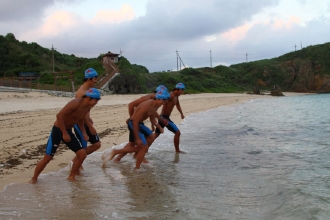 September 17, the start of the six-man swim from Yonagunijima Island, Okinawa.
September 17, the start of the six-man swim from Yonagunijima Island, Okinawa.
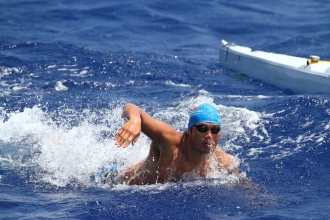
"Wait a minute, the surface current may actually be weakened due to the typhoon," thought Suzuki. Suzuki and his team trusted their instincts and took the gamble. In a rush, they changed their plan and decided to swim the direct route to Taiwan, making it a 110 kilometer trip. The 40 kilometers meant the time will be reduced by twelve hours. The start time was also moved up to 7AM.
To be on time for the ceremony at the finish line (set up by the Taiwanese), they had to arrive by 10AM on the 19th, so this shortened distance was certainly an advantage. Though they did run into another major problem.
As Suzuki explained, "The sharks were a concern so we built a five meter electric barrier called a 'shark shield' and swam behind it. Another problem was the needlefish. They have narrow, pointed beaks and divers often are impaled; so at night, we used only bicycle flashlights secured to our heads and the lights on the escort canoe. Thankfully, although we saw sea turtles and whales, we never encountered sharks or needlefish. Unfortunately, Kohei Yamada from Soma was stung by a man-of-war (highly poisonous jellyfish) which was a painful experience for him.
The six members took turns swimming 30 minutes each. Meaning they could rest for two and a half hours before their next turn. During the swim, Suzuki and the swimmers avoided unnecessary thoughts. They concentrated solely on swimming quickly and gaining distance. They didn't know if the swim would be called off due to the influence of the typhoon. There was 51 hours left until the time limit expired.
"We sprinted quite a lot. I knew the first 24 hours would be crucial. If we could only reach half way at that point, we had to decide whether to continue (due to the typhoon's influence). Then I thought about all the people supporting us and didn't want to stop. I wanted to convey this feeling of gratitude, so I swam as hard as I could," stated Suzuki.
They focused on natural human strength. They didn't rely on special wetsuits for ocean swimming for flotation, instead they chose to use just swim trunks. They endured jellyfish stings and electrical shocks from the shark field. The high water temperature caused dehydration after 30 minutes of swimming, so they drank a liter of water each time. The six members desperately stroked the ocean's surface to get even one meter closer to Taiwan.
Then, on the 18th, in the darkness at 4AM, the seas became turbulent. It was violent enough to cause them to fear for their lives. Suzuki recounted, "The sea became turbulent and I truly felt I was in danger. Had the escort canoe flipped over, there wasn't enough visibility to find anyone that went overboard, so at one point went back to the boat. Strong winds, large waves, and darkness - these three things coming together created a bad situation. We all waited together for the sun to come up."
To the Finish Line Joined By 100 Taiwanese Swimmers
"At 24 hours after the start, we completed two thirds of the swim faster than expected. Then, 36 hours later we were off the shores of Taiwan. We knew all that was left was the six of us to swimming in together for the ceremony next morning. On the boat, we felt a sense of relief for reaching this point without accidents, as well as sense of accomplishment for doing so in such a short time. It gave us confidence. We also thought about cultural exchanges with the Taiwanese people for next year," beamed Suzuki.
The next morning, over 100 swimmers greeted them in the bay of Su-ao and we swam to shore together. On land, we saw many happy faces. I was so ecstatic, I felt a sharp feeling in my nose.
The messages from the governors of Miyagi, Iwate, and Fukushima were handed to Mr. Chin-tien Yang (minister of foreign affairs) in Taipei. The expression on the faces of the six swimmers, including Suzuki, was full of accomplishment unending smiles.
Did the swim carry the message?
The answer shall be found in Japan and Taiwan's future.
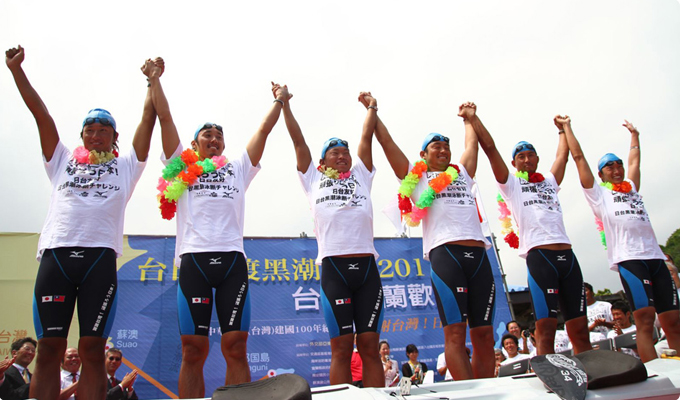 At the finish line in Su-ao, Taiwan on the 19th, they were interviewed by many media outlets and congratulated. "Thank you, Taiwan!"
At the finish line in Su-ao, Taiwan on the 19th, they were interviewed by many media outlets and congratulated. "Thank you, Taiwan!"
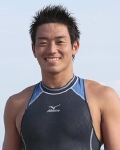
Kazuya Suzuki
Ocean athlete
Born December 1, 1972 in Gunma prefecture. Employed at Panasonic (at the time, October 2011). He started swimming competitively during early childhood and continued through the end of college. He participated in various swimming competitions, including those at the national level, and produced top results. From 2005, he began working as a lifeguard at Southern Beach; and in 2006, he began participating in outrigger canoeing. For three years consecutively, he tackled the 68 kilometer ocean swim between Izu Oshima and Chigasaki (only successful attempt was in 2009). His goal is to take on this challenge ten years in a row. In September 2011, he was part of a six-man team that swam 110 kilometers across the East China Sea (known for the Kuroshio Current) from Yonagunijima Island in Okinawa to Su-ao in Taiwan. He resides in Chigasaki, Kanagawa prefecture.
Translation: Paul Tokunaga
Text:Shun Sato
Photos:Masashi Urushihara
ENG version: 2012/07/26
Original JPN version: 2011/10/27
INTERVIEW
-

What We Need to Face in Order to Combat Poverty around the World
Toshi Nakamura
Co-founder and CEO of Kopernik, a non-profit rganization
2013/3/07 -

Overcoming choppy waters in society and at sea
Venturing into a new world
Laura Dekker
Sailor
2013/1/17 -

Behind the scenes of a high-rise building climb
Alain Robert
"French Spiderman"/ Free climber
2012/11/01 -

Freedom and Courage
Alain Robert
"French Spiderman" / Free climber
2012/10/11 -

Climbing the Fourteen Peaks: What the Eight-thousanders Mean to One Climber
Hirotaka Takeuchi
Climber
2012/9/27 -

Writing a tale of adventure about living life under extreme conditions
Yusuke Kakuhata
Nonfiction Writer and Explorer
2012/8/30 -

The 110 Kilometer Ocean Swim To Strengthen the Bond Between Japan and Taiwan
Kazuya Suzuki
Ocean athlete
2012/7/26 -

Now more than ever, we need to get back to basics.
Mike Horn
Adventurer
2012/6/21


